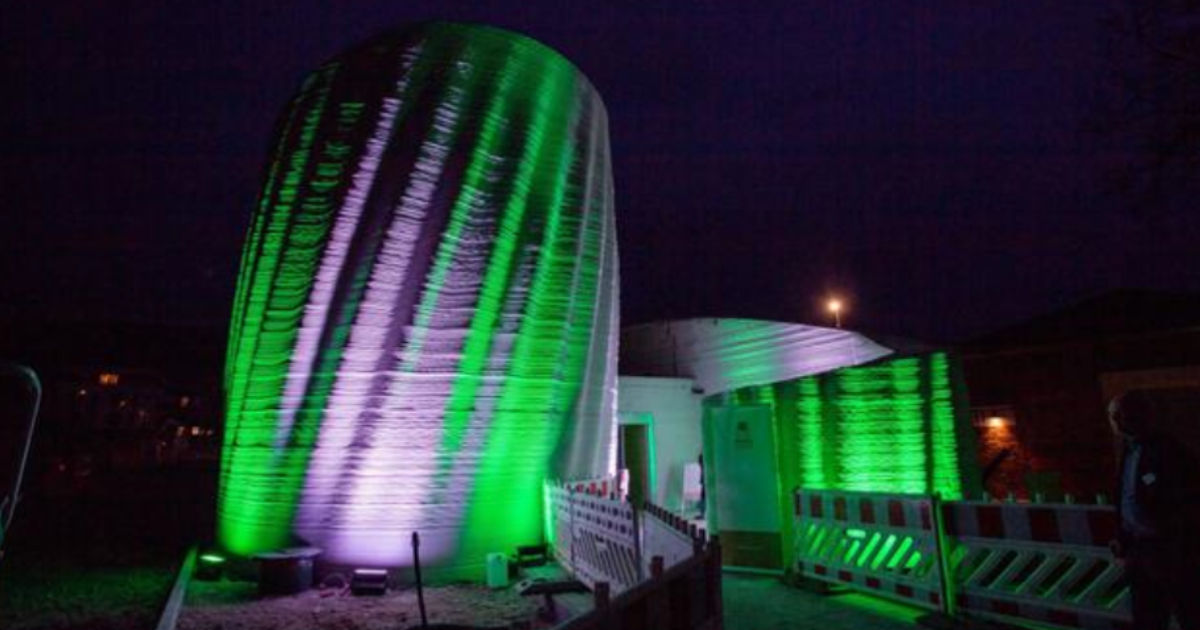
Europe’s largest 3D printed building has opened its doors recently but will these types of structures pave the way for an all-new era of construction, or is it more of a gimmick in the trade that will eventually fall out of fashion?
When considering that it only took 170 hours to “print” this impressive structure, a data centre in Heidelberg, Germany, this definitely leans away from the ‘gimmick’ argument.
There is certainly an upsurge in completed 3D printing building projects globally. In the US and Mexico, there have been full villages built with hundreds of 3D-printed homes, such as those created by ICON.
Saudi Arabia recently unveiled the world’s tallest 3D-printed building. With similar developments in Europe and planned 3D printed communities in Lancashire in England, it is clear that there is a growing popularity with the method of construction.
The method is certainly impressive looking—as robot arms squirt liquid concrete, or more like a form of grout, into layers that build up on top of each other, following a predetermined plan, manned by only one or two operators to oversee the process on handheld tablets.
The recipe for the material must be an exact science with just the right consistency to be able to squirt out of the printer but still stack up on top of the previous layer and not harden too quickly.
Apart from being quite impressive to behold and a very futuristic-looking method, there are several key advantages to using this approach to construction.
Benefits of 3D Printing
One of the main advantages with 3D printing is the reduction in time taken for construction.
The largest 3D printed building in Europe that has recently opened its doors took only 170 hours, or around one week to complete.
The cost can also be dramatically reduced with 3D-printed construction. For example, a 3D-printed office building in Dubai had a 60% lower labour cost than traditional buildings of the same size.
There is also a reduction in waste in 3D-printed buildings, making it an inherently more sustainable construction method.
The process can be made more streamlined, leading to improvements in productivity, which again, results in cost savings.
3D printing allows Architects more geometric freedom meaning they can design and build structures that would not normally be possible with typical construction methods. This paves the way for innovative new forms of building designs.
3D-printed buildings can be made safer during the construction process due to the fact that the robots can take care of most of the hazardous parts of the job.
Challenges of 3D printing
There are several challenges facing the construction of 3D-printed buildings
One of the key challenges is with the material itself being used to build up the layers in the 3D-printed building. The material must be viscous enough to be squeezed out of the nozzle whilst at the same time having the required strength and durability to be able to support itself while it is being built.
With the concrete hardening after a certain amount of time, this means there is a limited timeframe to print the material. The overall structural integrity of the material once it has been built is another key challenge for this method of construction.
Up until recently, the quality of the printed material has been somewhat brittle, meaning that it has been struggling to produce load-bearing components using this method.
In Eindhoven in the Netherlands in May 2024, the first legally habitable house was constructed with load-bearing walls built entirely with a 3D printer.
The construction, in this case, is described as a Flintstones-style house, built out of a boulder-type structure. This innovative building method is known as Project Milestone, a collaboration between Eindhoven University of Technology, Saint-Gobain Weber Beamix, Witteveen+Bos, and Van Wijnen.
Cyber Crime in 3D Printing
One of the major but often overlooked challenges with 3D-printed buildings is the element of cybercrime.
At first, it may seem like the two are unconnected, i.e. what has squirting layers of concrete got to do with hacking into the mainframe?
However, there is a key cybersecurity implication with the widespread use of 3D-printed buildings as the process is automated, with all the data held within the 3D model that the printer itself is using on-site.
Reducing the Risk of Cyber Crime in 3D-printed Buildings
As the technology becomes more widespread, it will be necessary to have robust measures in place to combat the risk of cyber crime.
As construction companies utilise increasingly more advanced building technologies, these can open the business up to new kinds of cyber threats from criminals who target the emerging technology and lack of regulations and common knowledge surrounding the equipment and its use.
For this reason, it will become increasingly important for architecture engineering and construction firms to adopt a fully managed cybersecurity solution, with all the benefits that they can bring.
Electing to resolve all cybercrime-related matters in-house through your own IT department is a surefire way to open yourself up to some innovative new hacking method that may be overlooked by your own IT staff, but would be picked up automatically with a combination of scanning technology and dedicated experts in place to monitor and respond in real-time.
Another method to mitigate the risk from cybercrime associated with 3D printed buildings and their designs is to employ an effective use of cloud data storage and security.
If 3D-printed buildings are the main method of construction in the next 10 years for example, this could spawn a whole new type of crime as building plans are lifted and manipulated.
For example, a top-notch architect could have their designs stolen and replicated elsewhere if unauthorised access was given to the 3D plan; further to this, there could essentially be a new type of crime that would be categorised as construction jacking, or changing a predetermined build to suit the needs of the unauthorised user.
For example, a new oil rig that was supposed to be built could end up inadvertently creating a giant sculpture that said something like “just stop oil” if the plans could be altered and the automated process left to do its thing. Similarly, thieves could secretly install a sort of back door into the vault of a new bank being built, or something along those lines—a prison with an escape hatch, etc. or even just a vulnerability or weakness in one part of the structure that was only known to the criminal party.
It would be very difficult for a human operator to be able to tell if the squirts of concrete coming out of the machine were any different to the neatly drawn lines and diagrams in front of them.
One way to get around this security issue with 3D printed buildings would be to have an adequate off-site cloud data solution that keeps the 3D plans in a remote data centre that cannot easily be accessed on the premises by an unauthorised user.
Using secure cloud storage in conjunction with a high-end cybersecurity solution to monitor everything, this places construction businesses in the best position to provide innovative new construction methods whilst remaining fully secure in terms of their data and intellectual property.
Contact Lyon Tech
At Lyon Tech, we provide architecture and construction businesses with high end cloud solutions plus the end-to-end cybersecurity systems and threat detection needed to cover the entire system.
This means that even when adopting the most advanced construction methods such as 3D printed buildings, our clients can rest assured that they have the most robust cybersecurity defensive posture in place and can feel free to expand their horizons with innovative new ways of doing business.
If you would like to know more about the range of technological solutions that can help your construction business, contact our expert advisors today for a full review of the best options.




